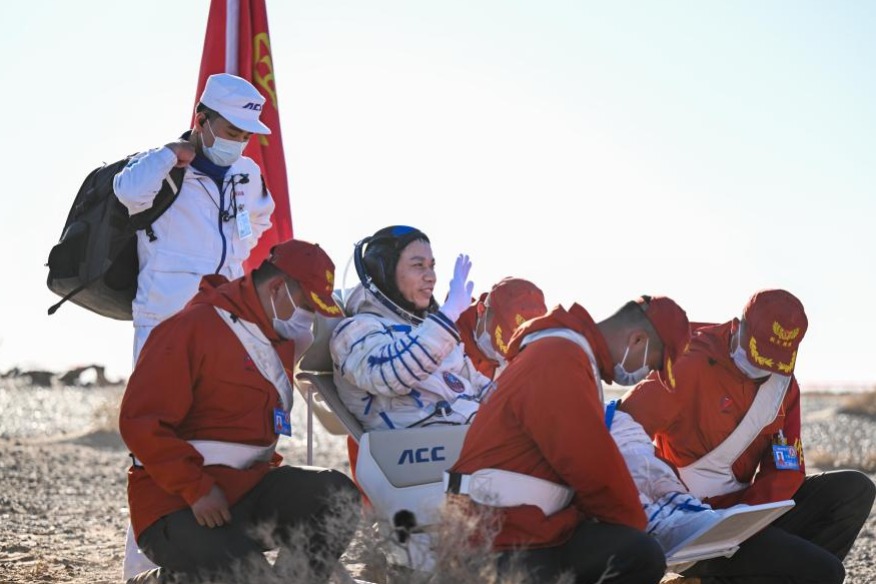The X, Y and Z on the path to higher learning
By Zhao Xu | China Daily | Updated: 2020-04-12 12:52

That path leads to self-discovery, as personal struggle is often viewed years later as an integral part of personal transformation. Zhao Xu reports from New York.
Asked about his change of mentality as a one-time PhD student, Fei Long, a senior staff engineer with Google, refers to a line graph depicting changes over time on two axes, x and y.
A few years after he graduated from Purdue University in Indiana in 2006 majoring in electrical and computer engineering, Fei came across the graph on phdcomics.com, a website reputed for its whimsical illustrations that gently poke fun at the world of academia.
The two variables shown on it are the time and the scale of a person's ambition. The x-axis begins at the point when he or she embarks on the journey to gain a PhD. Here self-expectation is at its zenith, with possibilities almost boundless, a Nobel Prize being one of them.
However, as the initial months of the first school year roll by, for many a student those aspirations, shown on the y-axis, rapidly diminish, and the quest for a Nobel Prize turns into a wish to be a revolutionary in one's chosen field. Achieving the former implies coming up with discoveries or ideas that send waves across the oceans and down the ages, while achieving the latter merely implies making breakthroughs in a specific field of research.
A bit of luck here and there can, of course, influence where you land up. But for many people, there's a marked difference between the two: in one case you take on the status of a god, in the latter you are destined to remain a mere mortal.
Yet as the first year draws to a close, for many who have unwittingly let their ego move into overdrive, anything less than being a revolutionary does not bear thinking about-until this student is halfway through the second year.
At that point on the y axis aspiration has been reduced to landing a job at a top university. Here one cannot help but detect a whiff of pragmatism: for the first time, lofty dreams have been swamped by mundane ambition. A respected job with a venerable institution will do, thank you very much.
On the graph, this descent into reality over three or four years is precipitous, even if, mercifully, it does not end in a crash but a soft landing, during which expectations gently taper off.
Now, in year four of studies, the modest hope of landing a job has given way to the hope of getting a gig at a conference in some rural backwater where, if you're lucky, the food of choice during dinner breaks will be pepperoni pizza. "The chart really gives a handle to understanding the mental journey undertaken by many PhD students, me included, although it may have failed to reflect the sheer delight most of us took in learning," Fei says.
"It has been almost 20 years since I first got enrolled in a PhD program in the US, long enough to change a lot of things. But students who have come from China pursuing a dream in one of this country's prestigious educational institutions have still got to ride the emotional pendulum propelled by the dual force of self-affirmation and self-doubt. It's a rite of passage, something that many of us look back on years later with feelings of gratitude."
Another one who has been through this all is Sun Tao, who last September became an associate professor at the University of Virginia, after having studied material science and engineering at Northwestern University in Illinois. After obtaining his PhD at Northwestern he worked as a staff scientist at Argonne National Laboratory in the town of Lemont, Illinois, for several years.
"Having spent six years at Tsinghua University in Beijing, I didn't feel an overwhelming pressure with academic work," Sun says, calling his alma mater "one of the world's best in science study and research".
But having a solid foundation does not necessarily mean a smooth transition. For a brief period in the US, Sun says, he struggled with English. But the ultimate challenge came from having to adjust to a new way of learning, whereby students are required to take the lead in identifying problems and solving them.
"I started to do research on my own two months after I entered Northwestern. You're expected to dive right in not only because this is what you set out to become: an independent research scientist. The nature and depth of a PhD student's work means that by the time of his or her graduation, the student is likely to command more knowledge in his or her chosen area of research than the professor. Therefore, a student must have the willingness to probe deeper on his or her own, although instruction from the professor, especially in the initial period, is crucial.
"Because of the lack of similar training during their undergraduate years, some Chinese students prove to be ill-prepared."
For students of social sciences, independence is often reflected in the level of critical thinking, says Li Fei, also a Purdue graduate, who was majored in both political science and industrial engineering.
"I thought I was going to spend my very first class feverishly scribbling down notes," Li says. "Instead we were asked to critique the reading materials we'd been handed. But no authentic view could be formed without a wide sampling of facts and opinions. Extensive reading, in both volume and scope, was not particularly emphasized by the curriculum I adopted in China, before entering Purdue."
However, being an independent learner and investigator should not diminish the importance of the student-teacher relationship, Sun says.
























